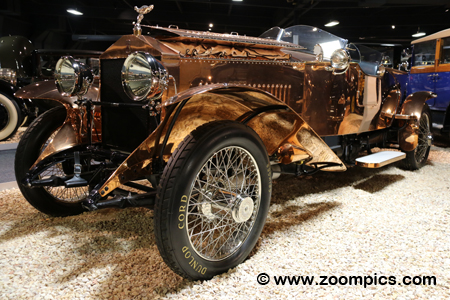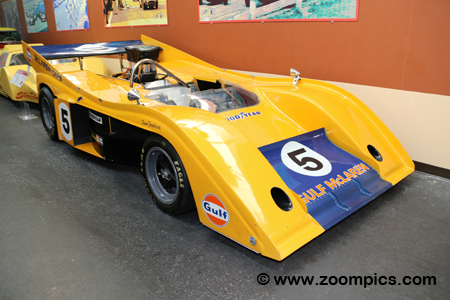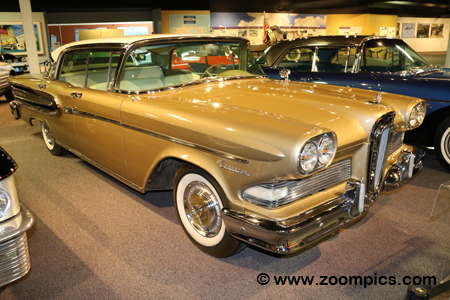|
The National Automobile Museum which opened in Reno, Nevada in 1989 has been recognized as one of the ten best automobile museums in America.
Much of the collection initially belonged to the late owner of Harrah’s Hotels and Casinos, Bill Harrah.
At one point, Harrah had assembled a group 1,400 significant vehicles.
After his death in 1978, Holiday Inns purchased his properties which included the cars.
Holiday Inns was going to sell the collection but bowing to public pressure they donated 175 vehicles and the research library to the new museum.
The remainder were sold at auction.
The mission statement of the National Automobile Museum is to collect and preserve the automobile for future generations,
with an emphasis on vehicles collected by William Fisk ‘Bill’ Harrah, to tell the story of the impact of the automobile on
American society, and to perpetuate the legacy of Mr. Harrah as a renowned collector.
|

|

|
This is the Beatnik Bandit II created by the legendary customizer Ed ‘Big Daddy’ Roth.
Roth who passed away in 2001 was famous for his unique vehicles and cartoon characters (Rat Fink).
The second version of the original Beatnik Bandit was built in 1994.
The fiberglass body is a one-of-kind and the paint colour is ‘lemon meringue pie’ from PPG.
A pizza oven was used to form the bubble top. The interior includes many digital gadgets.
|

|

|
Brothers, Louis and Marcel Renault understood the importance of racing to test and sell cars.
This vehicle was built by Renault to compete in the Paris to Vienna road race - an event that was 615-miles
through France, Switzerland and Austria. The model is a 1904 Renault Paris-Vienna Racing Voiturette.
It is powered by a 228.3-cu.in. four-cylinder which produces 14-horsepower.
|

|

|
A financial dispute between Henry Ford and his investors led to the formation of the Cadillac Automobile Company in 1902.
Under the leadership of Henry M. Leland, the company flourished.
This 1903 Cadillac ‘A’ Runabout debuted at New York’s National Automobile Show and orders were placed for 2,286 cars.
The engine in the Runabout is a one-cylinder Leland and Faulconer which produces 6.5-horsepower.
|

|

|
This is a 1921 Rolls Royce Silver Ghost.
From 1904 to 1949, Rolls Royce only produced a running chassis and the bodies were built by companies specializing in coachwork.
Built by Brockman Coachbuilders, this Rolls Royce was constructed using sheets of copper to avoid the need for welds and rivets.
The accessories are made from nickel and silver. Any wood used on the car is makash ebony.
|

|

|
The 1977 turbine-powered Steamin’ Demon was built by Jim Crank in attempt to beat the
land speed record of 127.656-mph set in 1906 by Stanley Steamer’s ‘Stanley Rocket’.
Crank was only able to reach a speed of 100-mph. The car was sold to Barber-Nichols Engineering who succeeded in going 145.607-mph.
During the record run the door blew off and the engine compartment caught fire.
|

|

|
This is a 1936 Mercedes-Benz Type 500K. Built by Daimler-Benz in Stuttgart-Unterturkheim, Germany the
body style is a ‘Special Roadster’ and the creation of Sindelfingen.
The 304.2-cu.in. supercharged eight-cylinder engine produces 160-horsepower.
The original owner of this particular Type 500K was Princess Nina Mdivani who was the wife of Denis
P.S. Conan Doyle (the son of Sherlock Holmes creator, Sir Author Conan Doyle).
|

|

|
Henry J. Kaiser and Joseph W. Fraser partnered in 1947 to form the Kaiser-Fraser Corporation.
Before business declined, they produced some innovative vehicles. One of these was the 1954 Kaiser-Darrin 161 Sports Car.
This model was designed by Howard Darrin.
The 161 Convertible featured sliding doors, fiberglass body and a three-position convertible top.
Production ended in 1954 after a total of 435 were constructed.
|

|

|
This is a 1972 McLaren M20 that competed in the Sports Car Club of America’s very popular Can-Am championship.
The series liberal rulebook resulted in cars with big engines and led to advances in aerodynamics.
The M20 is equipped with a 509-cu.in. fuel-injected aluminum Chevrolet V8 engine which produces 750-horsepower.
McLaren cars dominated the series until 1972 when Roger Penske and his Porsches appeared.
|

|

|
Only one of these 1937 Airomobile was built. The experimental car was constructed by Lewis American Airways of Rochester, New York.
This innovative vehicle used a front wheel drive layout and had only three wheels.
The Airomobile was fitted with a Doman-Marks air-cooled horizontally opposed four-cylinder engine.
The 60-horsepower motor allowed the car to reach a speed of 80-mph and average 43.6-mpg.
|

|

|
Mercer Automobile was in business from 1910 to 1925 and their primary financiers were F.W. and C.G. Roebling, builders
of the Brooklyn Bridge. This 1913 Mercer is a Series J, Type 35 with a Raceabout body style.
With the 300.7-cu.in. engine producing 58-horsepower the Raceabout was a successful race car.
For three consecutive years, the vehicle was victorious in the Chicago Automobile Club Trophy Race.
|

|

|
This is a 1988 Jaguar designed by Tony Southgate who was responsible for many successful race cars.
The model designated the TWR XJR-9 was prepared by Tom Walkinshaw Racing and competed in the IMSA series.
Powering these Jaguars was a 6-liter V12 overhead-camshaft engine.
Examples of this car won the 24-Hours of Daytona in 1988 and in 1990 before this model was retired it captured the 24-Hours of Le Mans.
|

|

|
This is Samuel Lambert’s vision of a Recreational Vehicle in 1921.
Lambert of the Lambert Pharmaceutical Company, the makers of Listerine Mouth Wash, used a Ford Model T as the basis of his concept.
The Kampkar could be fitted to the Model T in a couple of hours.
Features included seating for six and room to sleep four people.
Also included were a folding table, a two-burner stove and an 8-gallon water supply.
|

|

|
Another one of Ed ‘Big Daddy’ Roth’s creations on display at the National Automobile Museum is the 1992 Finkmobile.
The Finkmobile is powered by 150-cc water-cooled four-stroke engine from a 1989 Honda Elite motorcycle.
A single wheel is used to drive the Finkmobile while the front is fitted with four-wheel steering.
Like most of Roth’s concepts, the body is fiberglass.
|

|

|
In 1958 this Edsel Citation 4-Door Hardtop could be yours for $3,615. Edsel was a division of the
Ford Motor Company that built cars from 1958 to 1960.
Introduced to fill a perceived gap in the automotive market, sales never met the company’s expectations and production ceased.
The most distinctive feature of the Edsels was the vertical grill. This particular car is powered by a 410-cu.in. V8 engine.
|

|

|
De Soto was a division of the Chrysler Corporation and was established in 1928 to compete against Nash, Oldsmobile and Pontiac.
Initially, this proved to be a very successful line for Chrysler but by 1960 the company discontinued the brand.
This is a 1936 De Soto De Luxe Airstream Taxicab. It was one of 2,200 De Sotos order by a New York City cab company.
One of the unique features of the car was a sliding roof for more light.
|

|

|
One of the ‘crown jewels’ at the National Automobile Museum is the 1938 Phantom Corsair.
There is only one example of this unique car.
The Phantom Corsair was designed by Rust Heinz of the Heinz Ketchup company and Maurice Schwartz
partner in Bohman and Schwartz a custom body firm. Highlights of the vehicle included: aluminum body,
front-wheel-drive, electric gear shift, altimeter, barometer, etc.
|

|

|
The Packard Motor Car Company of Detroit, Michigan produced this 1938 1607 Convertible Coupe.
Between the two world wars, Packard’s were considered the top luxury line in North America.
However, competitors such as Cadillac started building more luxurious cars with larger engines.
The company shifted their strategy to lower cost models which caused Packard to close its doors in the 1950s and merge with Studebaker.
|

|

|
The Ideal Motor Car Company was formed by Harry Stutz in 1911 and two years later it was renamed the Stutz Motor Car Company.
The first vehicle Stutz built was entered in the 1911 Indianapolis 500.
Assembled in just five-weeks the car finished a credible eleventh.
But his most successful creation was the 1913 Bearcat.
The very popular Bearcat was powered by a 389.9-cu.in. four-cylinder engine which produced 60-horsepower.
|

|

|
This is a 1969 Chevrolet Corvair 500 Sport Coupe which is equipped with a 165.6-cu.in. air-cooled six-cylinder engine.
General Motors introduced the Corvair in 1961 – the following year over 315,000 of these were produced.
The car’s success only lasted until 1965 when Ralph Nader released his book about the car, ‘Unsafe at Any Speed’.
Sales plummeted and only 6,000 were sold in 1969 - the last year the car was manufactured.
|

|

|
The W.H. McIntyre Company attempted to build a cost-effective vehicle to compete with Henry Ford’s successful Model T.
In 1913, William B. Stout created the Imp Cycle Car.
Stout’s design used a two-cylinder motorcycle engine and four motorcycle wheels to create the two-seater.
Despite costing less than the Model T, it did not offer the same creature comforts - as a result, production of the Imp stopped in 1914.
|
|
Copyright Notice:
|
All content (photographs and text) appearing on this website are the exclusive property of © www.zoompics.com and are protected under International copyright laws. The subject matter on this website may not be reproduced, copied, stored or manipulated.
|
© Copyright 1999, 2000, 2001, 2002, 2003, 2004, 2005, 2006, 2007, 2008, 2009, 2010, 2011, 2012, 2013, 2014, 2015, 2016, 2017 and 2018


